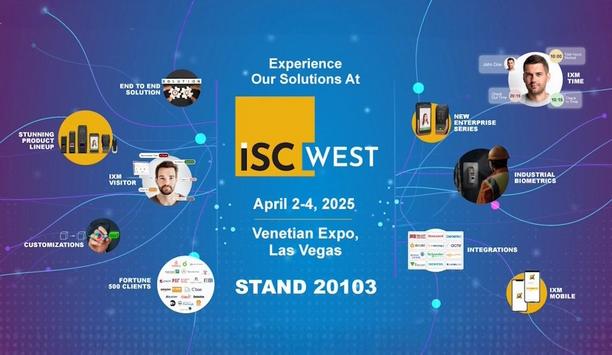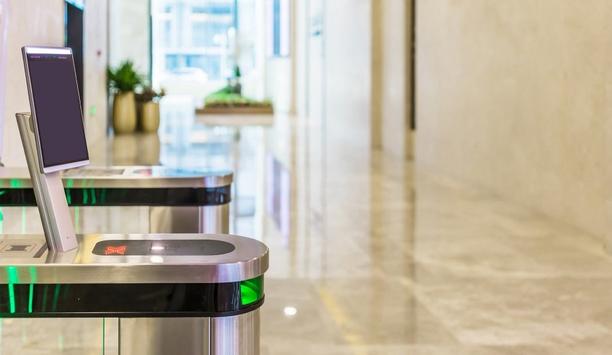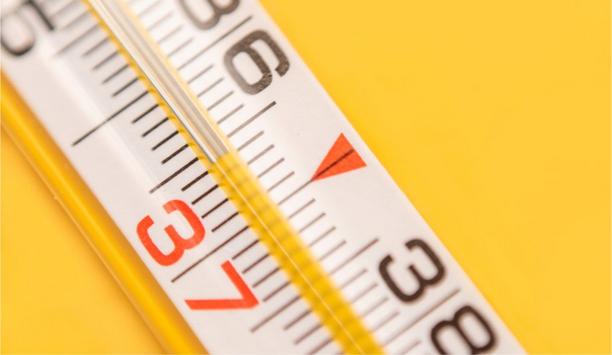Invixium - Experts & Thought Leaders
Latest Invixium news & announcements
Invixium, a pioneer in biometric access control, workforce, and visitor management, along with RTLS-connected worker solutions, is set to exhibit its latest Enterprise Series biometric solutions at ISC WEST. Making its entry into the North American market is Invixium’s effectively priced IXM ROSTO (face + card) and IXM TOUCH 3 (finger + card). These new products are purposely designed with relevant features for the Small-to-Medium Business (SMB) market. Invixium end-to-end solutions In addition, Invixium will also showcase its trusted portfolio of end-to-end solutions for heavy industries and critical infrastructure. “There’s never been a more exciting time to visit Invixium at ISC WEST,” said Shiraz Kapadia, CEO & President of Invixium. “We have achieved tremendous success in the industrial sector, and with the launch of the Enterprise Series, our goal is to deliver high-performance yet economical biometric solutions for the SMB market.” ROSTO features Enterprise Series solutions are sleek and versatile biometric devices designed for fast access control The Enterprise Series solutions, IXM ROSTO and IXM TOUCH 3, are sleek and versatile biometric devices designed for fast and secure access control, workforce, and visitor management. ROSTO features dual cameras for fast face recognition and a 5″ IPS LCD touchscreen for a clear and user-friendly interface. Equipped with a large 1:50K user capacity and Wiegand and OSDP connectivity to pioneering Access Control Panels, it also supports RFID, mobile, and QR code credentials, providing versatile authentication options. Invixium’s flagship solution TOUCH 3 is the newest member of the best-selling TOUCH series, offering advanced fingerprint authentication. It features a vibrant and responsive 3.5″ IPS LCD touchscreen, providing a clear and user-friendly interface for easy interaction. Equipped with an FBI-certified 500dpi optical fingerprint sensor, TOUCH 3 ensures precise and secure authentication. Attendees can also experience IXM TITAN 2nd Generation, now faster than ever, with an exceptional speed and high throughput of 28 faces per minute. Celebrated as Invixium’s flagship solution, TITAN is NDAA-compliant and specifically designed to withstand the toughest industrial and critical infrastructure environments. Invixium’s RTLS-connected worker solution Another highlight will be Triax, Invixium’s RTLS-connected worker solution Another highlight will be Triax, Invixium’s RTLS-connected worker solution. This innovative, easy-to-deploy solution features a patented and scalable mesh network, compact hardware, and actionable dashboards that identify and eliminate productivity pinch points. It enhances site safety, reduces muster times, tracks equipment usage, and triggers alerts for worker-generated injuries, delivering significant labour savings and maximising ROI. Invixium’s solutions at Stand 20103 Visitors will have the opportunity to experience live demos of Invixium’s solutions at Stand 20103. Thanks to strategic partnerships and seamless integrations with esteemed technology partners, their solutions will also be exhibited at Genetec – Stand 13062, Galaxy Control Systems – Stand 3077, and Honeywell – Stand 18059.
Invixium, a global pioneer in biometric access control, workforce, and visitor management along with RTLS-connected worker solutions, announces the launch of its new, effectively priced Enterprise Series – IXM ROSTO (face + card) and IXM TOUCH 3 (finger + card). Engineered with the same design-centric quality and cutting-edge technology as the Industrial Series, yet cost-effective for the mass market. Features for the SMB market “We want Small to Medium Businesses (SMBs) to experience Invixium the same way our Industrial customers have,” said Shiraz Kapadia, CEO & President of Invixium, expressing his excitement about the product launch. “In a nutshell, these products are priced to be extremely competitive and purposely designed with relevant features for the SMB market.” Modern connectivity features ROSTO supports RFID, mobile, and QR code credentials, providing flexible authentication options IXM ROSTO is a sleek and versatile biometric device designed for fast and secure access control, workforce, and visitor management. It features advanced facial recognition technology, dual cameras, and a 5″ IPS LCD touchscreen for a clear and user-friendly interface. ROSTO also supports RFID, mobile, and QR code credentials, providing flexible authentication options. Modern connectivity features ensure smooth data transfer and easy integration with pioneering Access Control Panels through IXM LINK. Its simple and elegant design makes it an ideal choice for applications across businesses of all sizes. Highlight features of IXM ROSTO Multifactor Authentication (Face, RFID or Mobile credential, PIN) Large User Capacity Digital Card and Dynamic QR Code support via IXM Mobile Liveness Detection to prevent spoofing PoE for easy installation Wi-Fi, BLE, and NFC OSDPv2 Support IP65 and IK08 Environmental Rating IXM TOUCH 3 TOUCH Series TOUCH 3 is fully compatible with all major access control panels via IXM LINK IXM TOUCH 3 is the newest member of the highest-selling TOUCH Series, offering advanced fingerprint recognition for secure and efficient access control, workforce, and visitor management. It features a vibrant and responsive 3.5″ IPS LCD touchscreen, providing a clear and user-friendly interface for easy interaction. Its slim design and angled fingerprint sensor ensure easy usability. It also supports multiple authentication options, including PINs, RFID credentials, and QR Codes, catering to diverse user needs. Additionally, its durable design and IP65 rating make it suitable for enterprises. TOUCH 3 is fully compatible with all major access control panels via IXM LINK. Highlight features of IXM TOUCH 3 Multifactor Authentication (Finger, RFID or Mobile credential, PIN) FBI Certified 500dpi Optical Fingerprint Sensor Digital Card and Dynamic QR Code support via IXM Mobile PoE, Wi-Fi and BLE option OSDPv2 Support IP65 and IK08 Environmental Rating Latest Enterprise Series at Intersec Dubai 2025 The Enterprise Series is now available for preorder by contacting the respective Invixium Sales Representative, shipping on March 31. Invixium showcases its complete portfolio of rugged biometric access control, workforce, and visitor management solutions, along with the latest Enterprise Series at booth S1-A16 at Intersec Dubai 2025.
Invixium, a global pioneer in biometric access control, workforce, and visitor management, along with RTLS-connected worker solutions, announces that they have signed a memorandum of understanding (MoU) that advances the In-Kingdom Total Value Add (IKTVA) program; an initiative that drives long-term economic growth and localisation initiatives in Saudi Arabia. The ceremony was attended by Shiraz Kapadia, CEO & President of Invixium, and Abdullah Alghamdi, Senior Vice President–Safety and Industrial Security, Aramco. Biometric innovation “Saudi Arabia is our largest market thanks to strategic customers like Saudi Aramco,” said Shiraz Kapadia, CEO & President of Invixium. “Aligned with the goals of the IKTVA Program and Saudi Vision 2030, we are committed to deepening our presence in the region by establishing our office and a production/assembly facility in the Kingdom in the foreseeable future." "This will enable us to locally manufacture our biometric solutions, generate employment opportunities, and develop biometric innovation and engineering expertise in the region.” Advancing localisation initiatives IKTVA aims to establish a level playing field for suppliers through transparent processes, the creation of supplier-focused partnerships, and regular quality assessments. The MoU recognises Invixium as a pioneering face recognition access control solutions provider in Saudi Arabia and strengthens its partnership with Aramco. It underscores their shared commitment to advancing localisation initiatives, fostering innovation, and contributing to workforce development within the Kingdom.
Insights & Opinions from thought leaders at Invixium
The last year revolutionised the way people work. When offices transitioned to work-from-home and worksites implemented social distancing, the security industry saw an overnight shift in what technologies our customers wanted. Now that businesses are bringing employees back to work in-person, management has broadened their focus to include healthy access in their security plans. Healthy access is a modern security concept that uses the latest technologies to blend employee and visitor health with automated security and digital transformation. This year, more leaders than ever are concerned with the health of their people – for good reason. Touchless Solutions Touchless solutions are at the forefront of security conversations because, suddenly, no one wants to touch anything in public. As a result, biometric solutions using face recognition have adapted to deliver a powerful and highly effective trifecta of solutions for physical security, health and workforce management. Face recognition is now considered to be the most accurate non-invasive method to identify and authenticate individuals Face recognition is now considered to be the most accurate non-invasive method to identify and authenticate individuals. Ongoing improvements like smarter algorithms, neural networks and artificial intelligence (AI) continue to improve face recognition’s performance. Well-known enhancements like faster processing and better camera functionality are quality-of-life improvements for traditional face recognition applications. Other advancements – like mask detection, face recognition while wearing a mask, mobile enrolment and more – are unique additions to this technology that effectively answer the needs of today without adding complex workflows. Biometric Face Recognition for Physical Security Even as pandemic mask restrictions lift, many businesses still require people to wear face masks to enter their facilities – a policy that will be with us for years to come. The sudden requirement for face masks in public stimulated the rapid development of a new face recognition application where security systems need to authenticate people with half their face covered. The ability to use a person’s biometrics to gain access eliminates the need for PINs or cards that can be forgotten, shared or stolen, so businesses familiar with the high security of biometrics cannot turn to less-secure means of authentication, and fingerprint is not a feasible option because that technology involves touching shared surfaces. Face recognition while wearing a mask is a highly relevant, timely advancement for businesses that need high security at their entry doors without compromising on mask mandates or personal comfort levels with illness avoidance. Biometric Face Recognition for Health Face recognition is touchless by nature and took centre stage during the pandemic Face recognition is touchless by nature and took centre stage during the pandemic as buildings migrated to contactless security to limit the spread of surface-borne illnesses. As more businesses reopen and bring office staff back, the demand for this fast, easy-to-use and touchless technology will continue to surge. Additionally, advanced face recognition solutions can be enhanced with thermographic cameras for elevated body temperature detection, which enables businesses to limit access to only people with healthy temperatures and prove that they are protecting healthy staff. To adhere to social distancing guidelines, businesses can take advantage of our society’s affinity for mobile apps. Remote enrolment is a feature of high-end face recognition solutions where people can enrol their faces using their phones – limiting the amount of time spent waiting in line, standing in front of a device or interacting with other people. Some solutions are also integrated with attestation questionnaires that allow people to self-declare symptoms or exposure to illnesses, which can help businesses make informed decisions to protect the health of their staff. The more your solution can accomplish, the more confidence your personnel can have that they are healthy at your building. Biometric Face Recognition for Workforce Management Returning to work is now a monumental undertaking. One of the biggest challenges for business owners is balancing hybrid work-from-home schedules and socially distanced in-person shifts. Every business will have a unique approach to what work in a post-pandemic world looks like. Touchless, mask-inclusive technology and attestation are user-friendly solutions that help businesses protect staff health This adds a new layer of complexity to shift scheduling that management must address to maintain the simplicity of shift changes and accuracy of time tracking. Touchless, mask-inclusive technology and attestation are user-friendly solutions that help businesses follow mask rules, ensure high security, protect staff health and keep shift changes fast and easy. Advancements in face recognition align with the timing of getting employees back to work because of work done by proactive security leaders. The “face” of biometrics has forever changed. This industry is no longer represented by antiquated fingerprint technology. Instead, we are represented by modern, accessible face recognition with room to grow for physical security, health and workforce management – the trifecta of healthy buildings.
As organisations look to reopen, management needs to implement new processes and technologies to help keep employees and visitors safe whilst adhering to government mandates and various industry compliance regulations. However, many specifics still remain unclear, creating apprehension for enterprises as they look for new solutions to ensure the health and safety of their personnel and businesses. This poses many challenges from a security and workforce management perspective. The need for elevated body temperature detection There has been much public discussion on the topic of fever detection, and you’ll hear a range of other terms being used to describe it as temperature detection, elevated body temperature (EBT) detection, temperature screening, and temperature measurement to name a few. All these words have different clinical meanings, not to mention different language nuances as companies try to decipher which solution best fits their needs and requirements. The problem with any or all of these new external detection “solutions” is that none provide a way to determine if an individual has a true clinically-defined fever. A clinical thermometer that measures one’s internal temperature usually requires insertion into the mouth, ear, rectum, or armpit. While no equipment can be 100% accurate, clinical thermometers have a variation of 0.3 to 1⁰F, with the ear being the most accurate location to measure core body temperature. COVID-19 creates a new problem for using clinical thermometers But, COVID-19 creates a new problem for using clinical thermometers: individuals responsible for taking temperatures cannot socially distance themselves while inserting an instrument into someone’s body. That instrument, which has now been in someone’s ear, must then be cleaned after contact. Conventional clinical core body temperature measurement is not only unsanitary to do on an enterprise-scale, it is also very, very slow. These challenges preclude large businesses from using this method for these very clear and pragmatic reasons. Thermal imaging technology Thermal imaging technology, which we refer to as “thermography”, provides a touchless option which serves the purpose of pre-screening without putting anyone at risk. However, thermography cannot detect a fever, which is any temperature reading above a specific point in a person. Being a reading of radiated heat, thermal imaging cannot measure the temperature inside the body. Instead, we can use thermography to screen elevated body temperature (EBT) to infer that someone may have a fever. EBT requires a reference point where we can safely say there is a core body fever based on surface temperature. What is a normal surface temperature? How high is too high? What is the threshold? Thus, thermography devices need to be calibrated against a black body. This is a large metal box where the device, like a thermal gun, is held to read a set temperature. Black bodies are used as the reference point for EBT; set the black body to the threshold temperature (e.g. the CDC’s threshold for a fever), calibrate the gun, and compare the black body’s radiated temperature to the forehead of the person being screened. This process, while quicker than using and cleaning clinical thermometers, still takes time and effort to set up every time the environment changes. Further, a black body is an additional expense businesses must incur to begin pre-screening temperatures. Touchless measuring The reason why we see so many thermal guns in lobbies now is because they are the simplest way to touchlessly measure temperature. The gun is held about an inch (2.54 cm) from the forehead, where there is the highest percentage of thin skin exposed on the body. The temporal artery on the forehead heats up the fastest in response to core body temperature changes, so thin skin is important to an “accurate” reading. In a practical sense, it’s just convenient. Until now, thermography was only occasionally used to screen temperatures in people. It’s more commonly used in cars and microwaves, where variation within an acceptable range matters less than it does in healthcare. Companies that make devices like thermal guns and other readers saw the market’s need and shifted into healthcare because businesses required a solution as quickly as possible so they could get back to being productive. Companies that make devices like thermal guns and other readers saw the market’s need The conversation right now is lingering on ambient temperature, and how the skin heats up in response to external factors. Is it cold outside? Is someone wearing a knit hat? Did they just dry their hair with heat? The reading on thermal guns and cameras can be higher or lower than the core body temperature as skin temperature changes with the environment, and that can prohibit someone who isn’t sick from going to work, or, worse, allow someone who does have a fever to enter the building and infect others. In a situation as dire as the one we’re in with COVID-19, those risks aren’t worth taking. Two cameras are better than one So, we now know that we need a quick, accurate and touchless way to measure elevated body temperature without it being affected by the environment. This is a big ask, but there is a solution. The medial canthus, the inner eye where the tear duct is located, is the only place on the face where thermography can come very close to determining core body temperature without the effects of ambient temperature. The tear duct is near the facial and temporal arteries and is not very susceptible to temperature variation from heat or cold from external sources. The only question is, how do we read a temperature from it? One would need a very high-resolution camera. IXM TITAN, our flagship biometric device, has a high-resolution camera for face recognition. Our research and development resulted in a solution where existing cameras work together with a secondary thermal infrared camera to screen body temperature. Dual-camera technology works like this: a high-resolution face recognition camera reads the face, then, based on an algorithm developed by Invixium, it pinpoints the tear duct and triggers the thermal camera to take a rapid reading of that area with a resolution of 320 x 240 pixels. The technology offers a variety of workflows if it reads a temperature above the threshold set in software. For example, if the technology detects an EBT, the system can deny access and keep the door locked, an alert can be sent out to HR, supervisors, or onsite security, or popup messages can be displayed on screen to provide next steps such as “report to security station” for further screening, which may be a clinical temperature check. Because it is self-contained and automated, there is no need for human intervention, and it can monitor temperature data to whatever extent an enterprise needs it to. This new, enhanced technology doesn’t replace true clinical temperature measurement devices, but does provide a safe, fast and accurate access control and workforce management solution that can help organisations get back to work with confidence in the new post-pandemic world. A safe, fast and accurate access control and workforce management solution Security in the new normal COVID-19 is changing our world in a lasting way. Technology can serve the purpose for right now, but also can be beneficial if it is scalable to incorporate other useful screening measures as an organisation's security needs change. In short, the best technology for your business is any technology that can grow with your company’s needs and the demands of the environment you do business in. Manufacturers of security products must always be conscious of how our solutions can be future-proofed using modern technology that pushes boundaries so we can continue to develop the most intelligent solutions for tomorrow’s world.
One system, one card
DownloadAligning physical and cyber defence for total protection
DownloadUnderstanding AI-powered video analytics
DownloadEnhancing physical access control using a self-service model
DownloadHow to implement a physical security strategy with privacy in mind
Download














